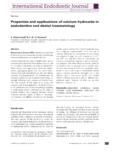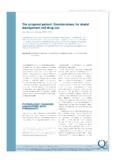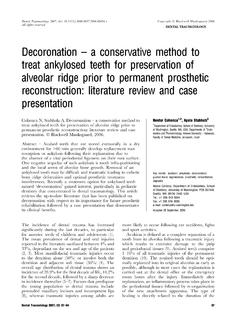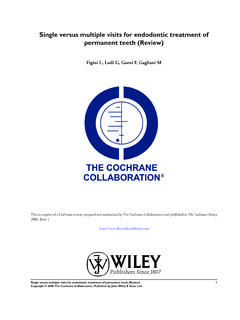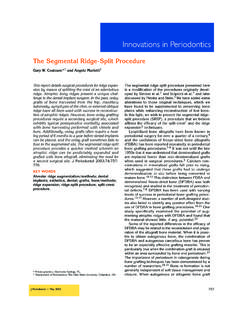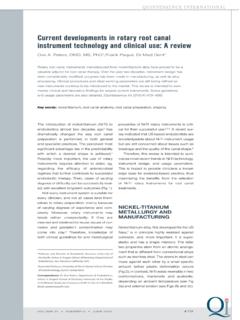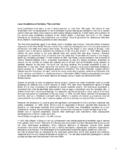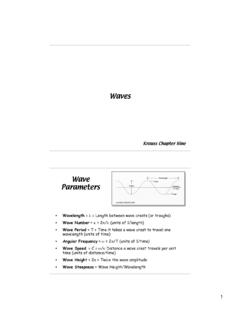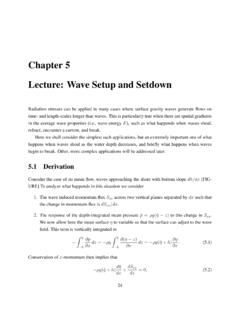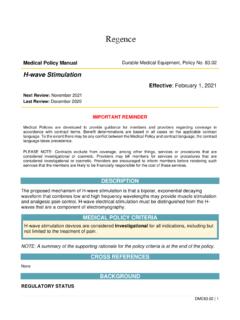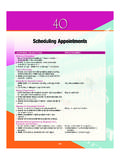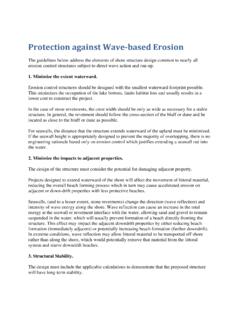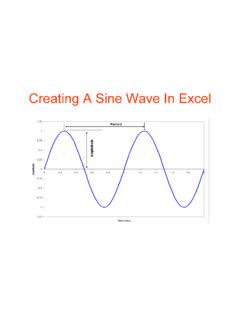Transcription of I WaveOne The WaveOne single-file reciprocating system
1 28 IIclinical technique _ WaveOne_The new WaveOne NiTi file systemfromDENTSPLY Maillefer is a single -use, single -file system to shape the root canal completely from startto finish. Shaping the root canal to a continuously tapering funnel shape not only fulfils the biologicalrequirements for adequate irrigation to rid the root-canal system of all bacteria, bacterial by-products andpulp tissue,1but also provides the perfect shape for 3-D obturation with , 3In most cases, the technique only requires onehand file followed by one single WaveOne file to shapethe canal completely.
2 The specially designed NiTi fileswork in a similar but reverse balanced force action4using a pre-programmed motor to move the files in a back and forth reciprocal motion . The files aremanufactured using M-Wire technology, improvingstrength and resistance to cyclic fatigue by up tonearly four times in comparison with other brands ofrotary NiTi are many dentists who, for whatever reason,are reluctant to use NiTi rotary instruments to preparecanals, despite the recognised advantages of flexibil-ity, less debris extrusion and maintaining canalshape, amongst other 8 Forthem, the use of a single reciprocatingfile will be very attractive both in terms oftime and cost present.
3 There are three files in the WaveOnesingle-file reciprocating system available in lengthsof 21, 25 and 31 mm (Fig. 1):1. The WaveOne Small file is used in fine canals. The tipsize is ISO 21 with a continuous taper of 6 %.2. The WaveOne Primary file is used in the majority ofcanals. The tip size is ISO 25 with an apical taper of8 % that reduces towards the coronal The WaveOne Large file is used in large canals. The tip size is ISO 40 with an apical taper of 8 % thatreduces towards the coronal instruments are designed to work with a reverse cutting action.
4 All instruments have a modi-fied convex triangular cross-section at the tip endFig. 1_WaveOne Small (yellow), Primary (red) and Large (black) 2_WaveOne apical cross-section, modified convex 3_WaveOne coronal cross-section, convex Wa v e O n esingle-filereciprocating systemAuthors_Dr Julian Webber, UK; Drs Pierre Machtou & Wilhelm Pertot, France; Drs Sergio Kuttler, Clifford Ruddle & John West, USAFig. 2 Fig. 3 Fig. 1I29clinical technique _ WaveOne Iroots1_ 2011(Fig. 2) and a convex triangular cross-section at thecoronal end (Fig.)
5 3). This design improves instrumentflexibility overall. The tips are modified to follow canalcurvature accurately. The variable pitch flutes alongthe length of the instrument considerably improvesafety (Fig. 4).Because there is a possibility of cross-contamina-tion associated with the inability to completely cleanand sterilise endodontic instruments9and the possi-ble presence of prion in human dental pulp tissue,10allinstruments used inside root canals should be instruments are a new concept in thisimportant standard of care, as they are truly singleuse.
6 The plastic colour coding in the handle becomesdeformed once sterilised, preventing the file from being placed back into the recommendation for single use has the addedadvantage of reducing instrument fatigue, which isan even more important consideration with WaveOnefiles, as one file does the work traditionally performedby three or more rotary NiTi WaveOne motor (Fig. 5) is rechargeable batteryoperated with a 6:1 reducing handpiece. The pre-pro -grammed motor is set for the angles of reciprocationand speed for WaveOne instruments.
7 The counter-clockwise (CCW) movement is greater than the clock-wise (CW) movement. CCW movement advances the instrument, engaging and cutting the movement disengages the instrument from thedentine before it can (taper) lock into the canal. Threereciprocating cycles complete one complete reverserotation and the instrument gradually advances intothe canal with little apical pressure brands of NiTi files can be used with theWaveOne motor, as it has additional functions forcontinuous rotation. However, as WaveOne files have their own unique reverse design, they can ONLYbe used with the WaveOne motor with its reverse reciprocating WaveOne technique involvesthe following stages:1.
8 Straightline access, acceptedprotocol;2. WaveOne file selection;3. single -file shaping;4. copious irrigation with 5 % NaOCland EDTA before, during and aftersingle-file file selection and clinicalprocedure (Figs. 6 8)Whilst a good preoperative periapical radiographwill give an indication of what to expect before the canal is prepared (size and length of the canal,number of canals, degree and severity of curvature),Fig. 4_WaveOne variable pitch fluteincreases 5_WaveOne motor and 6:1 reducing 6 8_WaveOne Small, Primaryand Large files with their respectivefile selection and clinical proceduralflow 6 Fig.
9 7 Fig. 8 Fig. 4 Fig. 530 IIclinical technique _ WaveOneonly the first hand file into the canal will aid in the selection of the WaveOne file as follows:1. If a 10 K-file is very resistant to movement, useWaveOne Small If a 10 K-file moves to length easily, is loose or veryloose, use WaveOne Primary If a 20 hand file or larger goes to length, useWaveOne Large shaping1. take hand file into canal and watch-wind to lengthor resistance (approximately two-thirds of canallength);2. use appropriate WaveOne file to approximatelytwo-thirds of canal length;3.
10 Irrigate copiously;4. take hand file to length and confirm with an apexlocator and radiograph;5. take WaveOne file to length;6. confirm foramen diameter with hand file the samesize as WaveOne file; if snug, preparation is complete;7. if foramen diameter is larger than WaveOne file,consider the next larger WaveOne file;8. majority of cases will be completed with WaveOnePrimary for use1. use WaveOne files with a progressive up and downmovement no more than three to four times, onlylittle force is required;2. remove file regularly, wipe clean, irrigate and con-tinue;3.

